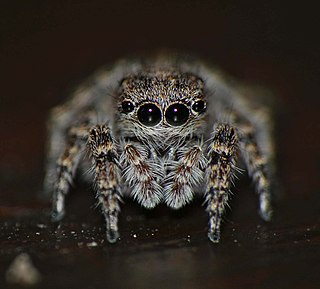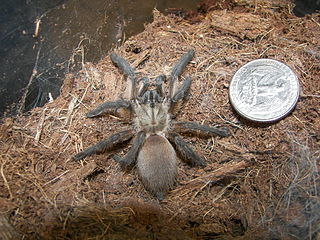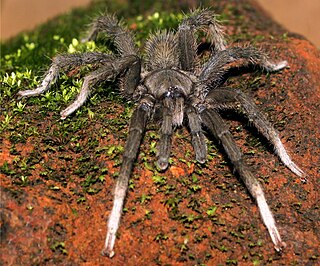
Langelurillus is a spider genus of the family Salticidae. All the described species occur only in Africa.

Macrothele is a genus of mygalomorph spiders in the family Macrothelidae, and was first described by A. Ausserer in 1871. Most species occur in Asia, from India to Japan, and Java, with five found in Africa, and two in Europe. The name is derived from Ancient Greek μακρός ("makro-"), meaning "big", and θηλή ("thele"), referring to the spinnerets.

Tarantulas comprise a group of large and often hairy spiders of the family Theraphosidae. As of December 2023, 1,100 species have been identified, with 166 genera. The term "tarantula" is usually used to describe members of the family Theraphosidae, although many other members of the same infraorder (Mygalomorphae) are commonly referred to as "tarantulas" or "false tarantulas". Some of the more common species have become popular in the exotic pet trade. Many New World species kept as pets have setae known as urticating hairs that can cause irritation to the skin, and in extreme cases, cause damage to the eyes.

Idiops is a genus of armored trapdoor spiders that was first described by Josef Anton Maximilian Perty in 1833. It is the type genus of the spurred trapdoor spiders, Idiopidae. Idiops is also the most species-rich genus of the family, and is found at widely separated locations in the Neotropics, Afrotropics, Indomalaya and the Middle East. Females live in tubular burrows lined with a thick layer of white silk. These typically have a D-shaped lid that fits into the entrance like a cork, and some burrows have two entrances. The lid may consist of mud, moss or lichen, which is bound below by a thick layer of silk. As in all genera of this family, the anterior lateral eyes (ALE) are situated near the clypeal margin, far in front of the remaining six eyes, which are arranged in a tight group. The males which are smaller in size, wander about or occasionally live in burrows. Like other mygalomorphs, they are relatively large and long-lived. Forest clearance and agricultural practices that loosen the soil and enhance erosion, besides soil removal for brick making have been pointed out as serious threats to some Indian species. Species ranges are poorly known – in India for instance, most species are known only from their type localities.
Heligmomerus is a genus of armored trapdoor spiders that was first described by Eugène Louis Simon in 1892.
Scalidognathus is a genus of Asian armored trapdoor spiders that was first described by Ferdinand Anton Franz Karsch in 1892. Originally placed with the Ctenizidae, it was moved to the Idiopidae in 1985.

Neoheterophrictus is a genus of tarantula in the family Theraphosidae. It comprises 8 species, all found in India.
Neoheterophrictus bhori is a species of tarantula. It is native to Parambiculam, Western Ghats, Cochin province, India, in present-day Kerala state.

The Eumenophorinae are a subfamily of tarantula spiders. They are known from genera distributed across Sub-Saharan Africa, the south of the Arabian peninsula, Madagascar and its associated islands, and parts of India.
Neoheterophrictus amboli is a species of theraphosid spiders, which is found in India.

Neoheterophrictus smithi is a species of tarantulas, native to India.
Neoheterophrictus madraspatanus is a species of spider in the family Theraphosidae, found in India.

Chrysilla volupe is a species of spider of the family Salticidae. It is found in Sri Lanka, India, Nepal, and Bhutan.
Tigidia is a genus of brushed trapdoor spiders first described by Eugène Simon in 1892.

Haploclastus is a genus of Indian tarantulas that was first described by Eugène Louis Simon in 1892. It is considered a senior synonym of Phlogiodes.
Heterophrictus is a genus of Indian tarantulas that was first described by Reginald Innes Pocock in 1900.
Sahydroaraneus is a genus of spiders in the family Theraphosidae. It was first described in 2014 by Mirza & Sanap.
Sahydroaraneus hirsti is a tarantula in the genus Sahydroaraneus, it is named after A. S. Hirst for his contributions in Arachnology. This tarantula is found in Thrissur, India. This tarantula was first described by Mirza and Sanap in 2014.

Stenaelurillus lesserti is a species of jumping spider found in southern India and Sri Lanka. The male has red and blue horizontal stripes on the front of the face while the female is dull. There are two transverse stripes on the prosoma.









